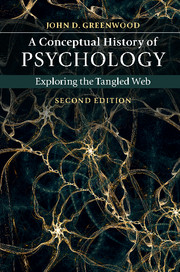Book contents
- Frontmatter
- Contents
- Preface
- 1 History, science, and psychology
- 2 Ancient Greek science and psychology
- 3 Rome and the medieval period
- 4 The scientific revolution
- 5 The Newtonian psychologists
- 6 Physiology and psychology
- 7 Theories of evolution
- 8 Psychology in Germany
- 9 Psychology in America: the early years
- 10 Functionalism, behaviorism, and mental testing
- 11 Neobehaviorism, radical behaviorism, and problems of behaviorism
- 12 The cognitive revolution
- 13 Abnormal and clinical psychology
- Epilogue: the past and future of scientific psychology
- Index
- References
4 - The scientific revolution
Published online by Cambridge University Press: 05 September 2015
- Frontmatter
- Contents
- Preface
- 1 History, science, and psychology
- 2 Ancient Greek science and psychology
- 3 Rome and the medieval period
- 4 The scientific revolution
- 5 The Newtonian psychologists
- 6 Physiology and psychology
- 7 Theories of evolution
- 8 Psychology in Germany
- 9 Psychology in America: the early years
- 10 Functionalism, behaviorism, and mental testing
- 11 Neobehaviorism, radical behaviorism, and problems of behaviorism
- 12 The cognitive revolution
- 13 Abnormal and clinical psychology
- Epilogue: the past and future of scientific psychology
- Index
- References
Summary
By the fourteenth century, the social, political, and intellectual order of the medieval world had begun to break down. Increased urbanization and the return to a money economy eroded the structure of the feudal system, and the rise of nation–states undermined the political authority of the papacy. Intermittent wars between the emerging nation–states led to a severe economic depression. This was followed by the plague of 1348–1350, later known as the “Black Death,” which decimated the European population and bred doubt and resentment against the medieval Church, the dominant authority. Although the Church embraced Aristotle's philosophy, the threat posed by its naturalism and rationalism generated dissent and division, initially leading to attempts to divorce the separate realms of faith and reason and then to the autonomous emergence of naturalistic empirical science.
Various developments contributed to the transformation of the intellectual landscape. Marco Polo's (1254–1324) exploration of China, Christopher Columbus’ (1451–1506) discovery of America in 1492, and Magellan's (1480–1521) circumnavigation of the globe expanded the horizons of the known world. Perhaps the most significant development was the invention of printing and the consequent transformation of communication. In the city of Mainz in southern Germany, Johann Gutenberg (c. 1397–1468) created movable type and published an edition of the Bible in 1450. The consequent explosion in printed works expanded intellectual horizons by broadening access to the Bible and classical works. By 1500, about eight million volumes had been printed (Pyenson and Sheets-Pyenson, 1999); by 1600, about twenty million, with over a dozen presses established in European cities (Foote, 1991). The critical interpretation of these works by humanist scholars encouraged a more secular – and more skeptical – approach to the classical tradition and scriptural authority, and the reliable reproduction of works in physics, astronomy, and medicine transformed science into a public enterprise. In earlier centuries, the works of Aristotle, Ptolemy, and Galen had been transcribed by hand by monastic clerics, with errors compounded over generations, and read only by the educated elite. From the mid-fifteenth century onward multiple copies of scientific works were critically scrutinized by the scientific community and educated members of the lay public.
- Type
- Chapter
- Information
- A Conceptual History of PsychologyExploring the Tangled Web, pp. 64 - 100Publisher: Cambridge University PressPrint publication year: 2015



